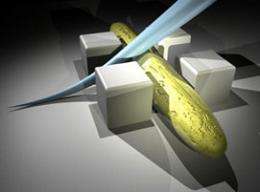Yeast injection. By using the broad edge of a micropipette’s flexible tip, scientists have developed a way to inject yeast cells with specific molecules.
(PhysOrg.com) -- If you want to know how a cell responds to a particular chemical, the experiment is simple: Inject it with that chemical. Micropipettes — tiny needles that can puncture a cell and deliver a compound directly into it — are used precisely for this purpose. But biologists who study yeast have not had this tool available to them. A yeast cell’s rigid outer wall is too strong to be penetrated.
Rockefeller University’s Paul Nurse, president and head of the Laboratory of Yeast Genetics and Cell Biology, and Daniel Riveline, a visiting professor from the French National Center for Scientific Research (CNRS), have developed a technique that solves this problem. They used a tiny electric motor in conjunction with a pipette to “saw” an opening in the cell’s tough outer coating. By borrowing tools from the microfabrication industry, the new method allows scientists to successfully introduce markers such as fluorescent proteins into Schizosaccharomyces pombe yeast without killing them.
Rather than use the sharp, pointed end of the micropipette, the scientists use the broad side of its flexible tip to bend the cell wall of a single rod-shaped yeast cell that is held in place by a microfabricated grid-shaped substrate. After the wall buckles, they turn on a piezoelectric motor to vibrate the pipette’s tip, opening a hole and allowing its contents to enter the cell.
“Not all the cells survive the procedure, but a significant number do,” says Riveline, the technique’s innovator, who began to assemble the apparatus in his lab in the Laboratory of Physical Spectrometry (CNRS/Grenoble University). “The cell is able to repair the hole and can continue to grow and divide.”
Because its processes of growth and division are similar to those of mammals, yeast is a useful model organism for cell biologists, particularly those studying the cell cycle. The technique opens up the possibility of new types of experiments in both S. pombe and S. cerevisiae budding yeast, which has a similar cell wall.
More information: Nature Methods 6(7): 513-514 (June 7, 2009) 'Injecting' yeast; Daniel Riveline and Paul Nurse; www.nature.com/nmeth/journal/v … /abs/nmeth.1335.html
Provided by Rockefeller University (news : web)


















